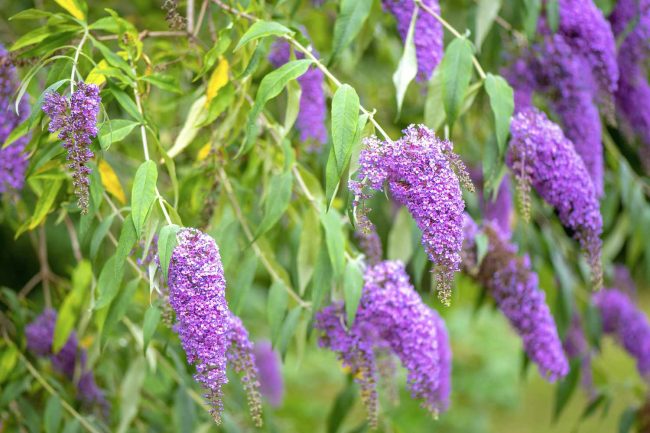The butterfly bush, or Buddleia, is highly attractive to bees, butterflies, and other pollinators, making it a favorite in pollinator gardens. Its vibrant, fragrant flower spikes are rich in nectar, which bees find irresistible. While it is a non-native plant and has some invasive tendencies, proper management makes it a beneficial addition to gardens aiming to support pollinators.
Here’s a closer look at why butterfly bushes are such a bee favorite, along with some considerations for gardeners who wish to attract pollinators responsibly.
Why Butterfly Bush Attracts Bees
Butterfly bush produces blooms in vibrant shades like purple, pink, white, and yellow, which are particularly eye-catching to bees. Key factors that attract bees include:
- High Nectar Content: Butterfly bush flowers are rich in nectar, offering a valuable food source for bees throughout the summer months.
- Extended Blooming Season: Most butterfly bushes bloom continuously from mid-summer to early fall, coinciding with the active foraging season of bees.
- Fragrance and Color: The blooms emit a sweet scent that draws in bees, while the colors, especially purple and blue, are especially attractive to them.
Benefits of Butterfly Bush for Pollinator Gardens

Planting butterfly bushes can help support local bee populations by providing a steady nectar source. For gardeners looking to create a pollinator-friendly environment, butterfly bush can be a beautiful addition that attracts a range of beneficial insects. However, since butterfly bush is non-native and can be invasive in some regions, gardeners should look for sterile or non-seeding varieties to prevent unwanted spread.
Alternatives to Butterfly Bush for Bees
If you’re concerned about the invasiveness of butterfly bush, native plants are excellent alternatives that also attract bees. Some popular options include:
- Bee Balm (Monarda spp.) – Rich in nectar and well-loved by bees and butterflies.
- Black-Eyed Susan (Rudbeckia hirta) – A vibrant, bee-attracting flower that blooms in late summer.
- Coneflower (Echinacea spp.) – Provides nectar and pollen and is a favorite among many bee species.
Growing and Maintaining Butterfly Bush for Bees
To maximize the benefits of butterfly bush for bees:
- Sunlight: Butterfly bushes thrive in full sun, which encourages abundant blooms.
- Pruning: Regular pruning keeps the plant healthy and encourages more flower production.
- Watering: While butterfly bushes are drought-tolerant once established, they benefit from occasional watering in dry periods.
Why you should think twice before you plant a butterfly bush
The butterfly bush is a shrub that originated in Asia and was initially grown as an ornamental; it is not indigenous to North America. As a result, no native caterpillar in North America is able to consume butterfly bush. Butterflies cannot complete their life cycle and their populations decline in the absence of host plants to feed their caterpillars.
Because it grows well in most garden settings, particularly in warmer areas and well-drained soils, the butterfly bush is a popular ornamental plant. Due to these circumstances, the butterfly bush is able to yield a large number of seeds that readily disperse outside of designated garden areas into natural areas. Each butterfly bush has numerous blossoms, and a single flower can yield 40,000 seeds.
The butterfly bush becomes an invasive species in certain natural places. Because it can displace native plants and ruin habitat, it is regarded as a noxious weed in some areas. For local caterpillars and other pollinators, native plants are essential host plants.
Therefore, even though the butterfly bush could seem to draw a lot of butterflies to your yard, it may really harm the local ecology by displacing native plants that are essential to the life cycles of butterflies and expanding into natural regions.
Adopt native plants to create a successful garden
Gardeners would be wise to plant native plants to support birds, butterflies, and other vital wildlife needs. These plants enhance the biodiversity in your garden by attracting butterflies and supporting them throughout their whole life cycle, from caterpillar to adult.
There are many lovely, native plants that are easy to grow and will better sustain butterflies and other animals, depending on your garden goals and where you live. Even tiny areas can support these natural butterfly bush substitutes.
Finally, a comparison of native plants and butterfly bushes
Think about these options rather than choosing the butterfly bush. These native plants will have a far more beneficial effect on the local butterfly population and the ecology overall.
When it comes to providing support for butterflies, native plants clearly win the struggle against butterfly bushes. The native plants increase the biodiversity of your garden by giving local butterflies, other pollinators, and even birds food and a place to live.
Frequently Asked Questions
Do butterfly bushes attract all types of bees?
Yes, butterfly bushes attract various bee species, including honeybees, bumblebees, and solitary bees.
Is butterfly bush invasive?
In some regions, butterfly bush is considered invasive. Opting for non-seeding or sterile varieties can help control its spread.
When does butterfly bush bloom?
Butterfly bush typically blooms from mid-summer through early fall.
Are there native alternatives to butterfly bush?
Yes, native plants like bee balm, black-eyed Susan, and coneflower are excellent pollinator-friendly options.
How can I prune butterfly bush for best growth?
Prune in early spring to encourage new growth and increase bloom production throughout the season.